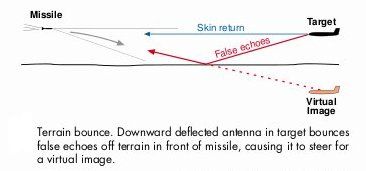Whenever you make a declaration, especially in the technical realm, it would help the readers, and your credibility, to support your argument, like this...
This is assuming single/fixed point/location transmission.
We know that sound velocity profiles (SVP) are affected by many factors such as salinity, temperature, and pressure...
Sound Transmission in the Ocean - sea, depth, oceans, temperature, salt, system, wave, marine, salinity, Pacific
Sonar Propagation in Statified Waters - March/April 2010, Volume 14, Number 2 - Archive - Hydro International
Some use sound speed (SSP) profile instead of 'velocity'...
Multibeam Systems - Sound Velocity Instruments
Coastal regions, estuaries, and river/sea connections have highly brackish water -- for example -- that can produce salinity stratifications that will produce diverse localized VSP that no standard sonar system can adequately compensate as explained by the above source when it demand that these profiles must be updated even by the hours.
This is why the US regularly conduct overt and covert profiling of the world's coastal regions to gather as much data over time as possible to create -- for each country that have sea access -- a 'meta-profile' of its sonar characteristics. The electronic warfare (EW) analogy is electromagnetic (EM) reconnaissance of a country based upon everything EM, from radars of military and civilian nature to daily television and radio transmissions.
There are also multi-paths propagation, same as radar detection, in shallow waters due to sea floor and those temperature/salinity layers...

Ghosting is a common problem in both radar and sonar detection because of multi-paths propagation.
So deep channel tracking is highly successful because of the constant SVP created by high pressure and fairly uniform salinity but only if a sub is in deep water.
A 'variable depth sonar' is essentially a sonar whose operating depth can be changed on demand to compensate for those layers that can hide a body. Intentionally or not.
No, I will not. There are many parallels between radar detection and sonar detection, especially in the data processing realm where they are practically identical and I do not have civilian experience in either. The military does not have exclusivity in using 'variable depth sonar' systems. There are many natural threats to civilian vessels that are hidden by those underwater characteristics that require the use of these systems to expose those natural threats and enhance marine safety.
What I normally do is bring to the discussions foundational principles that many interested lay readers do not know and ended up making baseless claims. You failed to bring up those foundational principles as how I demonstrated above. Then once a reader did his own research to verify my sources, those baseless claims usually disappeared. The reader is free to make up his own mind on whether the military applications of those foundation principles, as claimed by the military and/or manufacturer of said equipment, are credible or not. It is very difficult for anyone to dispute an operational capability -- as claimed -- once he understood the foundations of said capability. That is the way it should be without me crossing any infosec threshold.
Sonar 'jamming', while technically is real, is practically and tactically dangerous. More so than with radar detection. If you do not know where and how radar and sonar detection are similar and diverge, at the theoretical level, then there is no need to discuss this further.
How is infrared applicable in sonar detection? I could be missing something here. Must be old age and memory loss.
Hi again Gambit,
I am glad you are back.
The links you have provided are nice but I think you just Googled them and you have not deeply realized the basic physics underlying the beam forming techniques.
My main point in the last post was:
'variable depth sonar' is not one entity. It is highly dependent on the beam-forming strategy and dynamic electronic focusing.
http://www.curtistech.co.uk/papers/beamform.pdf
You can not just say 'variable depth sonar' is the answer to shallow water objects. Which type of 'variable depth sonar' strategy?
The strategy for 'variable depth sonar' relies on these parameters that you failed to address:
%%%%%%%%%%%%%
1. Number of arrays? array shape?
2. Kerf, array spacing
3. Sound frequency
4. single pulse, multi-pulse, Doppler, back propagation, combined
5. focusing on transmit (# of focal points)
6. focusing on receive (# of focal points)
%%%%%%%%%%%%
Since you are interested in technical points, I suggest you address these points and then we can run a simulation on the acoustic field together and observe the results of its interaction with the object.
Copy and pasting a link does not prove anything but you can Google.
Conclusions are made upon simulations, experiments, and statistical analysis.



 . remember?
. remember?